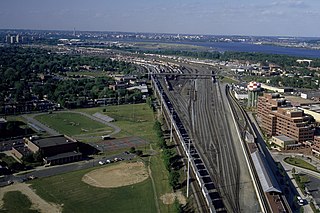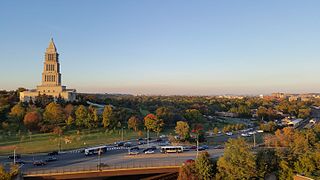
Alexandria Union Station is a historic railroad station in Alexandria, Virginia, south of Washington, D.C. To avoid confusion with nearby Washington Union Station, the station is often referred to as simply Alexandria. Its Amtrak code is ALX.

Jonathan Shipley was a clergyman who held offices in the Church of England, who became Bishop of Llandaff from January to September 1769 and Bishop of St Asaph from September 1769 until his death.

A racino is a combined race track and casino. In some cases, the gambling is limited to slot machines, but many locations are beginning to include table games such as blackjack, poker, and roulette.

Potomac Yard is a neighborhood in Northern Virginia that straddles southeastern Arlington County and northeastern Alexandria, Virginia, located principally in the area between U.S. Route 1 and the Washington Metro Blue Line /Yellow Line tracks. The area was home to what was once one of the busiest rail yards on the Eastern Seaboard of the United States. The "Potomac Yard" name is also used to refer to several developments in the area, especially the Potomac Yard Center power center and a Washington Metro station.

Saint Asaph was, in the second half of the 6th century, the first Bishop of St Asaph, i.e. bishop of the diocese of Saint Asaph.
Off-track betting is sanctioned gambling on greyhound racing or horse racing outside a race track.

The Shops at Tanforan is a regional shopping mall in San Bruno, California, United States. It is located on the San Francisco Peninsula, 10 miles (16 km) south of San Francisco city limits.

The Northern Virginia trolleys were the network of electric passenger rails that moved people around the Northern Virginia suburbs of Washington, D.C., from 1892 to 1941. They consisted of six lines operated by as many as three separate companies connecting Rosslyn, Great Falls, Bluemont, Mount Vernon, Fairfax City, Camp Humphries and Nauck across the Potomac River to the District of Columbia.

Longacres was a Thoroughbred horse racetrack in Renton, Washington, United States. Owned by the Gottstein/Alhadeff family and operated by the Washington Jockey Club for the vast majority of its existence, the racetrack was the home of Thoroughbred racing in Western Washington from its opening in 1933 and was the longest continuously running track on the West Coast upon its closure. Until 1971, it was also the only place in Western Washington where gambling was legal. Notable races held at the racetrack include the Longacres Mile Handicap and the Gottstein Futurity.

Luna Park was a trolley park in Alexandria County, Virginia that operated between 1906 and 1915. The amusement park was built for $500,000 in just three months by the Washington, Alexandria, and Mount Vernon Electric Railway, which was seeking to attract new businesses along its line after nearby racing and gambling establishments closed.

Alexandria is an independent city in the northern region of the Commonwealth of Virginia, United States. It lies on the western bank of the Potomac River approximately 7 miles (11 km) south of downtown Washington, D.C. Alexandria is the third largest "principal city" of the Washington metropolitan area which is part of the larger Washington-Baltimore combined statistical area.
The Hart–Agnew Law was an anti-gambling bill passed into law by the Legislature of the State of New York on June 11, 1908. It was an amalgam of bills enacted as Chapter 506 and 507 which were sponsored by conservative Assemblyman Merwin K. Hart and Republican Senator George B. Agnew.

Ingleside Terraces is an affluent residential neighborhood of approximately 750 detached homes built at the former location of the Ingleside Racetrack in the southwestern part of San Francisco, California, United States. It is adjacent to the Balboa Terrace, Ingleside, Merced Heights and Lakeside neighborhoods, and is bordered by Ocean Avenue to the north, Ashton Avenue to the east, Holloway Avenue to the south and Junipero Serra Boulevard to the west. The main local event that occurs is the Annual Sundial Park Picnic, in which the local residents host bicycle, chariot, and wagon racing. There is a large sundial located on Entrada Court, surrounded by the oval-shaped Urbano Drive, which was once a horse race track. Ingleside Terraces is one of nine master-planned residence parks in San Francisco.

Andrew "Cap" Tilles was an American business magnate and philanthropist. At an early age, Tilles adopted his childhood nickname of Cap, which he used for the rest of his life. Tilles revolutionized the United States horse racing industry. Later in life, Tilles dedicated his resources to philanthropic projects in St. Louis, Missouri. In 1896, he co-founded and actively ran an investment syndicate that dominated the US horse racing industry through World War I. The investment syndicate became known in the media as the "Big Three," after its three principal partners: Louis A. Cella, Samuel W. Adler, and C. A. Tilles. The syndicate was officially known as C.A.T., which was short for the Cella, Adler, and Tilles partnership.
Horse racing in the United States dates back to 1665, which saw the establishment of the Newmarket course in Salisbury, New York, a section of what is now known as the Hempstead Plains of Long Island, New York. This first racing meet in North America was supervised by New York's colonial governor, Richard Nicolls. The area is now occupied by the present Nassau County, New York, region of Greater Westbury and East Garden City.

Louis A. Cella was an American capitalist, turfman, and plutocratic political financier. In 1896, he co-founded the Cella, Adler, and Tilles investment syndicate, alongside partners Cap Tilles and Samuel Adler. The partnership, also known as C.A.T., dominated the Midwestern horse racing industry through World War I. At its height, C.A.T. had a controlling interest in 25 horse racing tracks. Additionally, C.A.T. founded the Western Turf Association, which granted Cella and his partners near monopolistic control over jockeys, bookmakers, and horse owners in the Midwest. The partnership also had one of the largest networks of bucketshops in the US, with a presence in every major city in the country. Cella was nicknamed the "Dago Saloonkeeper," a reference to his early start as a saloonist before co-founding C.A.T. Cella made a fortune in real estate, commodities speculation, stock commissions, and horse racing. At the height of his career, Cella owned five large office buildings, controlled ten theaters, several hotels, and a large network of brokerages across the US.
Alexandria, Virginia, an independent city in the Commonwealth of Virginia, is located along the western bank of the Potomac River. The city of approximately 151,000 is about six miles south of downtown Washington, D.C.
The Municipal Handicap was an American Thoroughbred horse race for horses of either sex age three and older. It was held at Morris Park Racecourse in The Bronx, New York from inception in 1895 through 1904 when the racetrack closed. It was then run at the newly built Belmont Park from 1905 to 1909 then revived in 1914 and run until 1918 when the race was discontinued.

Driving Park was a harness racing track in Rochester, New York which operated between 1874 and 1902.

Crandal Mackey, sometimes spelled Crandall, was an American lawyer and newspaper publisher. He served as the commonwealth attorney of Alexandria County, Virginia from 1904 to 1916, and led raids in Rosslyn, Virginia of gambling dens in 1904.















